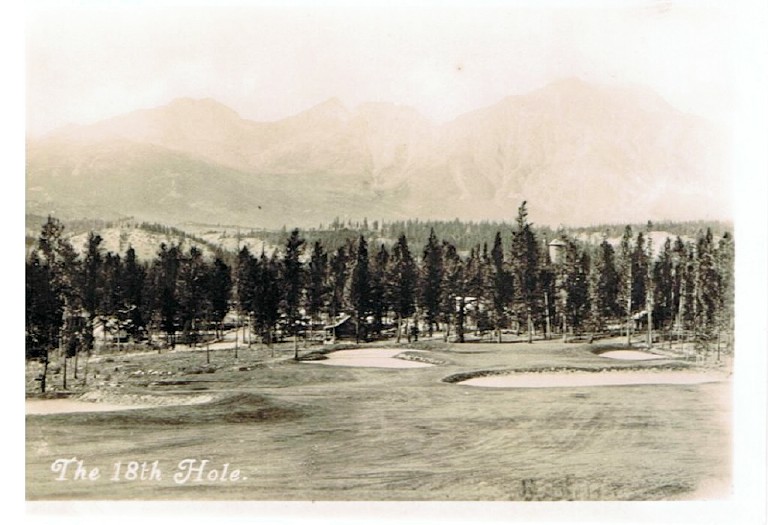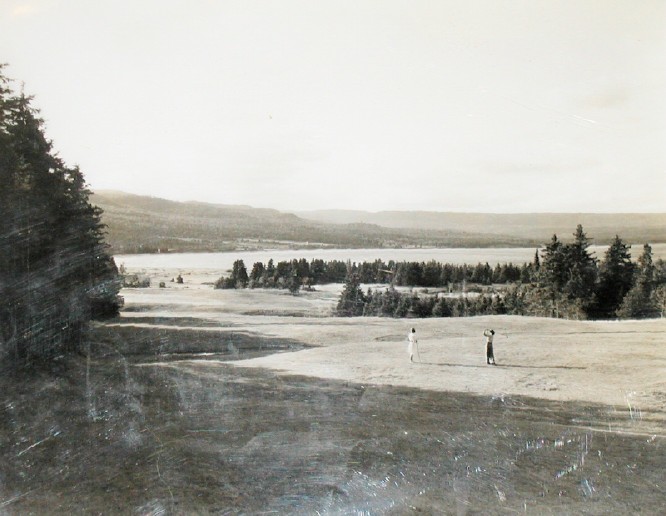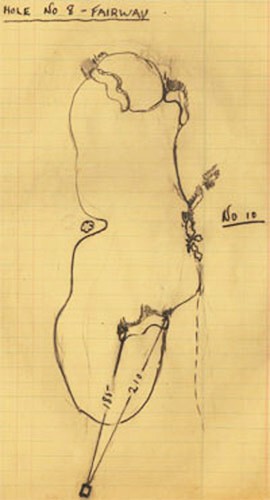Feature Interview with Stanley Thompson
March2006
Canadian Stanley Thompson is a legend for not only how he designed and constructed golf courses but for how he lived as well. From Vancouver’s Capilano to Cape Breton Highlands Links, along Nova Scotia’s rugged Atlantic coast, Canada isleft with a fine set of testimonials to Thompson’sarchitectural genius. Amazingly, Ian Andrew and Jeff Mingay recently caught up with ‘The Toronto Terror’ at the Cutten Club in Guelph, Ontario… a club Thompson contends he still owns, despite serious objection from the University of Guelph (curiously, Andrew and Mingay also claim to have spotted Elvis at a Tim Horton’s the same day)!

The Toronto Terror
1.Throughout your life,you claimed to have been born in Scotland.
I was born in Scotland.
2. But your biographer, James Barclay (author of The Toronto Terror, The Life and Works of Stanley Thompson), has official records that indicate you were actually born in Toronto?
No, I was born Scotland.
3. How did you become interested in golf course design?
Well… my brothers and I grew up caddying at the old Toronto Golf Club. We all became very good players… even though I refuse to carry more than five clubs!
In 1923, on the even of the Canadian Amateur, some smart-ass stole my set – spoon, baffy, cleek, mashie and putter. I borrowed replacements and spun a 72, to take the medal play honors though! In match play though, I blew up (laughing)!
Anyhow… the Toronto club was set to move to a new location about 1911, and brought the famous British architect Harry Colt over to layout a new course. I was about 14 years old at the time, and we were fortunate to be able to watch Harry’s new Toronto course come to life.
It was fascinating.
A few years later, Harry returned to Canada to design another new course for Hamilton Golf and Country Club. My oldest brother, Nicol, was head professional there.
Toronto and Hamilton were by far the two best courses in Canada at the time. I had a unique opportunity to see firsthand how world-class courses were built.
At that point, I began to consider the idea of designing and building golf courses myself.
4. Following your service in Europe during the First World War, did you visit any of the famous courses throughout the British Isles?
As a matter of fact, I did. My younger brother Frank and I traveled to St. Andrews following the Armistice. And we also looked at a few courses around London.I was an admirer to Willie Park Jr., so we stopped in to have a look atSunningdale and Huntercombe.
5. Shortly after the War, you went into business with your brother Nicol and Toronto Golf Club’s well-known Scottish professional George Cumming. How did that come about?
After the war, there was a market developing in Canadafor new golf courses. My brother Nicol and George Cummingwere very well known throughout the country at the time, as golf professionals and course designers. They had each designed a number of courses by the end of the War.
Nicol had worked on the Brantford course, and George had laid out Mississauga where I played regularly. George had also written many articles ongolf course design, construction and upkeep.
Soit was a perfectarrangement for me… teaming up with Nicol and George, because they had plenty of work. Our company, Thompson, Cumming and Thompson, designed and constructed golf courses. And we also constructed designs by other architects, like the old York Downs course in Toronto for Charles Alison. We built the Lakeview course, too, across the road from Toronto Golf Club,designed by HerbertStrong. Herbert and I became very good friends.
Within a few years, we were very busy. My brother and George actually had to choose between their club jobs and continuing with our work. They decided to go back to their club work.
I first reorganized the company as Lewis & Thompson, following an arrangement with an American firm, in 1921. That quickly dissolved though, so I formed Stanley Thompson and Company the following year.
6. Aside from practical experience in the field of design and construction during the early 1920s, how else did you educate yourself about golf course architecture?
I traveled see the best courses in the Untied States. I visited National Golf Links and Pine Valley. I like Pine Valley, but there’s room in golf for only one course like Pine Valley.
I also enjoyed reading… books like Dr. MacKenzie’s Golf Architecture, George Thomas’ Golf Architecture in America, The Links by Robert Hunter, andMr. Colt’s Golf Course Architecture.
I never had the desire to write a book. Although, I eventually a booklet, in 1923, that’s titled General Thoughts on Golf Course Design.
7. Which one of your courses best exemplifies your philosophy, as outlined in that booklet?
Banff.
The fairways (there) were purposely made doubly wide so that there were at least two distinct routes to each hole. Originally, one could stand on the tee and judge which route to follow. For the bold there is a short route, harassed by bunkers, but the reward for such is a birdie. For the short player, the other is a long route, free from bunkers. As soon as the course opened, all classes of golfers enjoyed Banff, for the novice is not discouraged by unfair trapping nor is the course too easy for the experienced expert.
8. William Van Horne of the Canadian Pacific Railway was the visionary behind the development of Banff Springs, wasn’t he?
Mr. Van Horne was a great visionary. I liked him a lot. He was in love with the Rocky Mountains, and dreamed of developing a series of luxury hotels along the CPR line amidst the beautiful mountain scenery throughout western Canada. Visitors to the hotels would naturally arrive by train, which was good business for the CPR. Van Horne always said, if we can’t export the scenery, we’ll import the tourists.
9. Your Banff Springs course is said to have cost more than $1 million to construct. That was a very healthy budget during the late 1920s, wasn’t it?
I can’t recall what the budget, but I distinctly recall it wasn’t enough (laughing)! I figured we’d just get going at Banff, and when we ran out of money, Van Horne would have no choice but to provide the rest!
Construction of the course turned out to be much more difficult than I had anticipated.
Van Horne decided to drop in to take a look when he thought the course was almost complete. Well, when he arrived, he discovered we were barely half way through and threatened to fire me on the spot (laughing)!
But, I convinced him to take a walk with me, to see what the CPR was getting for their money. I walked him out to the Devil’s Cauldron hole, where we shared a couple nice cigars and talked about the course. By the time we returned to the hotel that evening, Van Horne had promised me more money to finish up (more laughter).
10. Apparently, Jasper Park was over-budget too?
Young men, you should never worry about what you spend. Worry about what you create. Once they see what you have done, they always forgive you for how much more you’ve spent.
Jasper wasn’t supposed to cost more than $500,000 to construct. But, by the time we’d spent that amount, the course wasn’t even close to finished. I had to go to the railroad board (Canadian National Railway) and beg for more money (laughing)! I told them… “Gentlemen, you wouldn’t spoil a ship for a hap’orth of tar, would you?” (more laughter) They recognized the logic and appropriated the extra to complete the course.
You know… I’ve spent more than $80 million of other people’s money. I naturally would have had to watch my step if it were my own (even more laughter)!

One of Alister Mackenzie’s favorite Home holes – the 18th at Jasper Park
11. Speaking of money, it’s said you’ve made and lost at least three fortunes.
In this business, you’re sometimes broke a long time before you realize it (laughing)… when you do realize it, you have another stake at the bank!
I definitely had a penchant for getting into side ventures that didn’t work out (laughing)!
In the early 1940s, I founded Associated Shepherds, Limited. At the time, it appeared that wool shipments from Australia might get choked off. So, we flooded country clubs throughout Canada and the United States with literature suggesting that sheep be turned loose on the fairways. I pointed out that the Scots had used sheep as grass croppers long before the days of mowing machinery. One acre of rich ground would support two sheep and that ewes yielded an average lamb and a half a piece per year. A number of courses acquired a flock, but we soon called off the crusade because Australians began shipping wool to North America again!
Ha! After we called it quits, I’d occasionally receive little boxes of sheep clippings in the mail, sent from someone with an obviously warped sense of humor (laughing)!
There was another time when I purchased $25,000 of the finest quality seed from a merchant in Britain. Ten ton, sight unseen! We were in a hurry to put it down, so we skipped the usual government germination tests before accepting delivery. Well… none of it germinated! Not one blade of grass!
$25,000… down the drain!
Following some investigation, I learned that on the way to Canada, the seed was stored next to the boilers on the ship! The seeds were roasted by the time they arrived in Canada (laughing)! Soon after, I left for Florida… had to relax my nerves!
Ah… I was convinced once, too, that I’d figured out how to prevent cutworms by placing a thin layer of crushed ground glass under the greens. The idea was that when cutworms crawled up to get at the tender grass roots they would slice themselves to death (laughing! The glass seemed to reduce the worm colony, but for some reason, the grass died too!
Oh… I missed out on a big fortune too. Did I tell you? I had met an inventor a few years back, from Schenectady, who had come up with an idea to use metal shafts in golf clubs. He wanted me to invest in his company, but I told him there was no replacement for good solid hickory. Boy was I wrong (laughing)! Soon after, the Royal and Ancient legalized the use of metal shafts… and the rest is history, as they say!
12. You occasionally caused a stir with your design work, too… tell us about the famous Cleopatra hole, the ninth, at Jasper Park.
Oh, was Thornton (Sir Harry Thornton of the Canadian National Railway) ever upset with me!
Harry and I played golf at Jasper for the first time together, and when we arrived at the ninth tee he stopped and just stared down at the hole. I had a good idea what he was starring at. He had finally noticed the hole was modeled after a woman reclined on her back (laughing)! Well, Harry blew a gasket! He said, “Mr. Thompson, we have been friends for many years. I never thought you would have the audacity to do this to the Canadian National!”
I had no choice other than to make some minor alterations to the hole, to hide the woman’s form! The hole no longer resembles a woman, but it kept its name!
13. And, you were almost arrested during construction at Capilano, weren’t you?
Now here’s a good story (chuckling)!
The men were clearing trees at the lowest point of the property there, to provide views of downtown Vancouver from the course. I gave them some simple directions regarding the trees that needed to come down. As more trees came down, the views of downtown, the new Lion’s Gate Bridge, and the ocean appeared in amazing fashion. Apparently, the men got a little carried away though and cleared some trees on an adjacent property, off the golf course site (laughing)!
Well, it all came to an end one day when a Sheriff came up to the site from Vancouver to arrest me. He said we’d cleared trees off someone else’s property. I casually asked him to come up to the clubhouse to talk it over. We had a drink, I explained that I had no idea those men were not on the Capilano property, and apologized for what had been done.
Well… while we were chatting, the Sheriff marveled at the views that had been opened up by the tree clearing. He let me go (laughing)…
14.We understand Cape Breton Highlands was your idea.
Yes… I successfully sold the federal government on the idea of building courses in our national parks as make-work projects during the Great Depression. Along with Cape Breton Highlands, we also had a national park course at Anne of Green Gables on Prince Edward Island under construction.
I submitted a report to the government that clearly explained that there are no attractions in our national parks that have proved more popular than the golf courses. And, to maintain these courses at a high standard of perfection should be our ambition, whether they are self-supporting or not. I told them that the better the national parks courses are maintained the more revenue will accrue to the parks in a general way.
The government people agreed. I only had to guarantee that we would only use bulldozers and steam shovels when absolutelynecessary, so that the men were always working.Cape Breton Highlands and Anne of Green Gables were, for the most part, builtby hand.

The 2nd at Cape Breton Highland circa 1939 with its magnificent unobstructed views.
15. How did you go about routing Cape Breton Highlands over such a large, difficult property?
All I had was an aerial photograph. I worked out a basic routing using that photograph, but spent a lot of time walking the property as well. The entire area had been cleared for pasture and farmland, so the holes were easy to see. And the views out to sea at holestwo, three, four, five and six were breathtaking… those seaside holes reminded me of links.
So, I assigned Ken Gullan,a very capable Scotsman on the construction crew, to give those holes a definite links feel. Marram grass was growing in abundance along the Cape Breton coast, but for whatever reason, not on the golf course site. So, Kenobtained marram grass from elsewhere and transplanted it along those seaside holes.

Though over-treed, a recent aerial shows the stunning property at Cape Breton with which Thompson had to work.
16. Typically, how detailed were your drawn plans for new courses?
I only made detailed plans on paperwhen I knew my on-site time throughout construction of the course was going to be limited.I also enjoyed making models of the greens using plaster of Paris. We’d paint the greens and fairways, and use sprinklings of sand for the miniature traps. For Capilano, I made models for all eighteen greens. But at Cape Breton Highlands, I only made one or two. We worked out the details of the greens in the field.

A Thompson hole sketch, with interesting playing angles.
17. How much design input did your associates have while you were away from a project?
Very little… they were there to build the course, not design it.
I recall at Cape Breton, I constantly stressed that I wanted the greens there tobe built as close to the ground as possible. But Geoff Cornish continued to push me! He argued about the third green in particular. The third is a beautiful par-three hole next to water, where the green site flooded a few times during construction. Cornish tried to insist that the green should be raised two or three feet above the natural grade. That’s not what I wanted. It would look unnatural. I wanted that green as close to the ground level as possible. And that’s where it is.
Another time, I met Robbie and Geoff out at the tenth hole at Cape Breton Highlands. While I was away, Robbie decided the tenth green would be better placed across the river. And it seemed Geoff agreed. I explained to them that was not where I wanted the green and that they better get it built if they wanted the chance to finish it before I left.
18. Of all the places you worked throughout your career, which was your favorite?
We built a charming course in Jamaica, called Constant Spring… (Robert) Trent Jones and I.
Trent and I arranged for a cigar maker to set-up shop right at the third hole (laughing)! The idea was that golfers would order custom-made smokes there, continue the round, and have the cigars waiting for them at the eighteenth green (laughing)! If only they had a good scotch in Jamaica, rather than that God-awful rum down there, that project might have been even more satisfying than it was…
You know, though… I’ve enjoyed everywhere I’ve worked.
Every golfer has his dream course. But only some men actually have the money required to see their dreams materialize. I find the rich are the loneliest people in the world. And I believe that through my work I have helped some of them forget some of their loneliness. I was essentially a performer of good deeds!
The End

